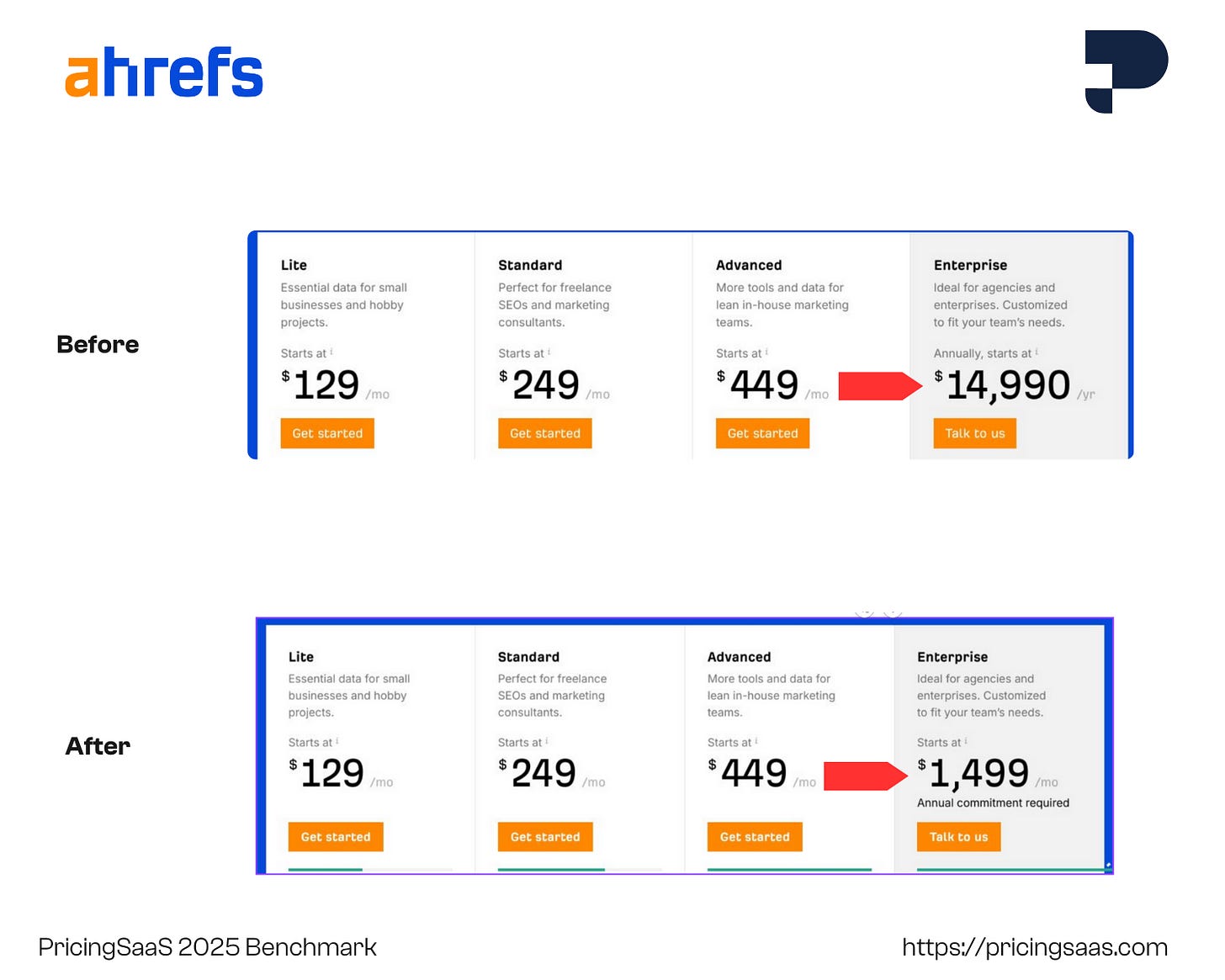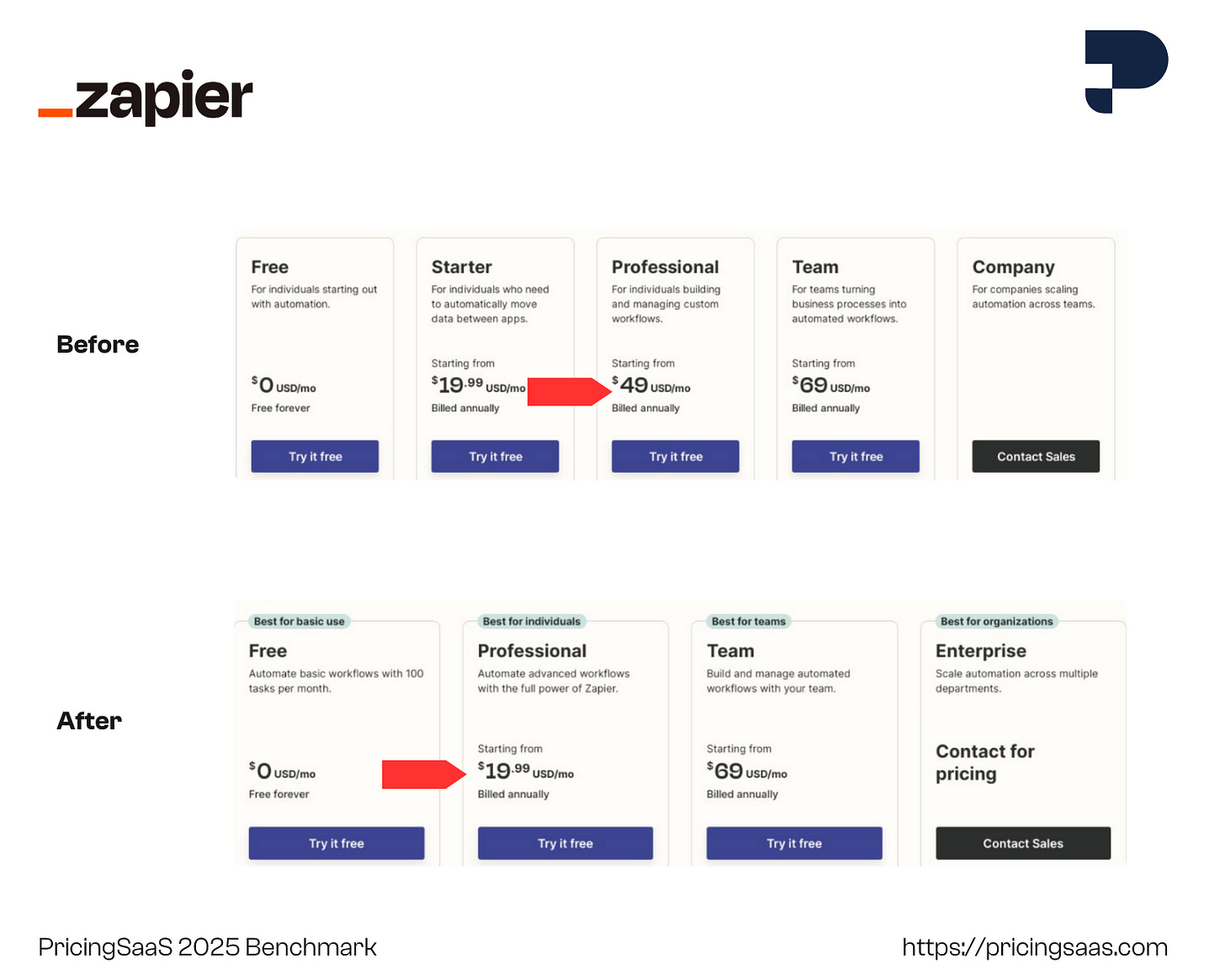The good, bad and ugly of SaaS pricing changes
The only constant in software pricing is change
👋 Hi, it’s Kyle Poyar and welcome to Growth Unhinged, my weekly newsletter exploring the hidden playbooks behind the fastest-growing startups.
The only constant in software pricing is change. Folks monetize new products, launch an Enterprise plan, raise prices, offer introductory discounts, or insert usage-based paywalls (looking at you, ChatGPT) — to tap into pricing as a powerful profit lever.
John Kotowski and Rob Litterst keep tabs on these changes through PricingSaaS, the pricing intelligence platform. I’ve invited them back to share the latest.
Tracking 3,500 of the top players in SaaS throughout 2024, one thing has become crystal clear: pricing strategy doesn’t sleep.
Across the PricingSaaS 500 index, we saw a total of 339 total changes – including 126 pricing updates (increases, decreases, discounts) and 213 packaging updates (new plans, plan consolidation). Within those changes, we found 29 companies changed prices multiple times, 31 changed plans multiple times, and 42 updated both price and plans.
The takeaway? The top players in SaaS are increasingly iterating on pricing and packaging. This should prove useful in 2025, when we expect pricing models to continue shifting from charging for access to charging for outcomes.
After inspecting the actual changes themselves, we have thoughts. Let’s comb through the good, the bad, and the ugly to help you make smarter pricing decisions and avoid common pitfalls in 2025.
The Good
Loom shifted from an AI add-on to an AI-focused plan.
Loom had been offering an AI add-on, but pivoted to an AI-focused tier late last year. The tiered approach offers a nice contrast to Notion, which monetizes AI as an $8 add- on. The difference is Notion offers a perpetual free plan that users can stay on forever. The add-on gives them a way to monetize their massive freemium base.
Loom’s freemium plan has a usage constraint of 25 videos, basically making it a different version of a free trial. In that context, an add-on doesn't make as much sense, since free users would run out of videos anyway, and need to upgrade to a paid tier.
The new tier gives Loom a straightforward way to monetize AI for business and Enterprise users. They also snuck a nice price increase in there, too 🔥
Pipedrive added an Enterprise plan and raised prices on the Advanced plan.
Combined, these moves will push more prospects to purchase the Professional plan, which is clearly their focus (note the Most Popular tag). The Enterprise plan serves as an anchor on the high end, making the Professional and Power plans look more affordable. Raising the price of the Advanced plan closes the gap on the low end, making the Professional plan look more appealing to budget-conscious prospects.
These pricing dynamics complement a meaningful upgrade in functionality between Advanced and Professional, including AI-powered sales tools, contract and proposal management, streamlined lead routing, and advanced reporting – giving even more reason for a prospect to pick the Professional plan.
(Since this update, Pipedrive doubled down, raising the price of Advanced even further, to $39 per month.)
Ahrefs craftily raised prices on the Enterprise plan.
On first look, it might seem like Ahrefs lowered the price of the Enterprise plan, but they actually increased the annual price by 20%. This is a smart, crafty move – and overdue.
Previously, the annual cost of the Enterprise plan was listed, making it hard for customers to compare the monthly price against other plans. This was likely done in an effort to emphasize the annual commitment for Enterprise, but it’s unnecessary. With this adjustment, visitors can easily compare the monthly prices of each plan, and it’s still clear that Enterprise customers need to sign an annual contract.
I’ve never understood companies comparing plans with different contract terms. It’s not the most important thing in the world, but it’s just an objectively worse experience for visitors. Kudos to Ahrefs for changing that, and raising the price in the process.
The Bad
Docker aggressively raised prices for its Pro and Team plans, but kept Business steady.
We generally believe many SaaS companies underutilize price increases. Docker raised the price of its Pro and Team plans by 80% and 67%, respectively. If you visit the Docker subreddit, you’ll notice many disgruntled customers. While the magnitude of the increase here is high, that’s not our issue – any time you raise prices, some customers will complain.
The bigger question here is why leave out the Business plan? Docker added value to Business, including new Security and Compliance features, but didn’t touch the price point. It’s not lost on me that you could use the same argument that I used for Pipedrive for Docker – that leaving Business the same will drive more customers to Pro and Team. That’s true, but that would still be the case if they raised the price of Business at a lower magnitude than Pro and Team. Business customers are the least price sensitive by nature, and this feels like a missed opportunity to drive incremental revenue.
Zapier replaced the Starter plan with the Professional Plan.
There are things I do like about this change from Zapier. They consolidated plans, and tightened positioning. But the new Professional plan offers the same functionality as the old one, at a 61% discount. At Zapier’s scale, a small change can make a big difference, and dropping the Professional plan by $30 is meaningful. This feels like a missed opportunity to meet somewhere between the original price of the Starter plan ($19) and the Professional plan ($49).
Also, swapping one plan for another like this signals that there wasn’t much thought behind the original plan mix. Hopefully this move changes that.
(It’s worth noting that Zapier’s pricing scales based on usage — the number of tasks completed by an automated workflow. Zapier may be making a bet that if they get more customers on Professional, they’ll drive more usage and higher LTV.)
The Ugly
Keep reading with a 7-day free trial
Subscribe to Kyle Poyar’s Growth Unhinged to keep reading this post and get 7 days of free access to the full post archives.










